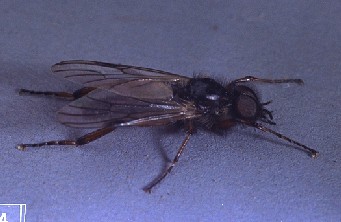March flies (Bibio sp.) look like gnats and are ¼- to ½-inch long. They have dark brown bodies that are elongated and somewhat hump-backed. The wings are small and a smokey translucent color. March flies have small heads that vary in shape with short antenna.
In early spring, especially late March and most of April in Nebraska these insects commonly form swarms. Swarms are abundant and large over lawns and landscape. Some swarms are so annoying that it is unpleasant to be in those outdoor locations. If a person drives a car through a large swarm, these insects can cover the entire front of the vehicle.
March flies' flight behavior is erratic and each swarm is short-lived. At times many of the males and females will attach themselves at the abdomen and fly as a linked pair. Moist early springs after a wet winter cause larger populations and swarms. The adults do not feed, but subsist on the nutrition gained in the larval stage. March flies do not damage lawns or landscape and will not harm any person, pet, or livestock.
The larvae of these insects are worm-like and feed on decaying organic matter in the thatch and soil. This is very beneficial for the lawns. They can very instrumental in decomposing materials in compost bins and garden beds. Any chemical control is not necessary, nor would it be effective in anyway. The photo of the March fly was taken by Ken Gray of Oregon State, and additional information can be found at http://oregonstate.edu/dept/nurspest/march_flies.htm

